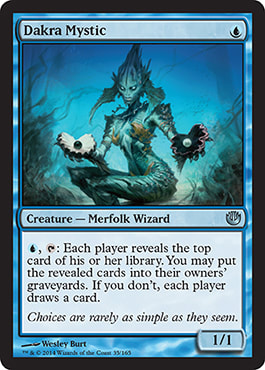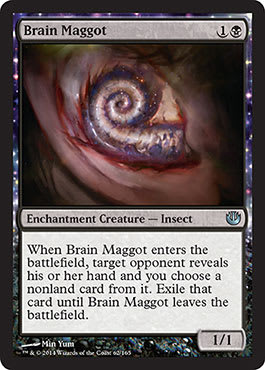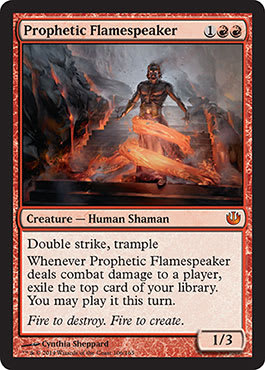Hello, Gathering Magic! This article will discuss Journey into Nyx's impact on Cube.
White
Aegis of the Gods – This is an upgrade from Onslaught's True Believer. Player-targeting effects in Cube are mostly Edicts, burn, and cards like Jace, the Mind Sculptor and Bribery, making it more of a R/B hoser. Due to the lack of targets and weak stats, this is a miss.
Banishing Light – This is a near-functional reprint of Oblivion Ring with a few marginal upsides and downsides, making it about on par with Oblivion Ring, a staple.
Dictate of Heliod – We've been seeing more token support through cards like Spear of Heliod and Master of Waves. Even in decks that aren't focused on generating tokens, this works well by pushing your army over the top and at instant speed, earning its mana cost by ending the game shortly after or having a lasting effect that generally pushes the game in your favor. Due to this flexibility, it’s a solid role-filler.
Godsend – The overall effect for 3 and 3 mana isn't very good. Vulshok Battlegear compares for the pump and mana effect, although Godsend does provide evasion from its exile ability, but the high mana cost of both effects makes this compare unfavorably to non-staple Equipment like Loxodon Warhammer.
Launch the Fleet – Launch the Fleet is a card that is great when you have several creatures to attack with but poor otherwise. Think of how often battalion happens in Cube, which is about the lowest number of attackers to make this worthwhile, and you'll see why this is a miss.
Nyx-Fleece Ram – Unlike other cards such as Wall of Omens and Spellskite, this doesn't offer much utility outside of hosing creature decks. Because of this, it's a good tool if need be, but a pass otherwise.
Blue
Battlefield Thaumaturge – Much like Aegis of the Gods, Battlefield Thaumaturge is a card that looks better than it actually is due to the limitation to instants and sorceries. This puts it into territory of more tempo decks that play cheap threats and either protect the threats or pave the way for them. Blue tempo cards need to be good enough to play in non-tempo decks—such as Kira, Great Glass-Spinner or Master of Waves—and Battlefield Thaumaturge isn't.
Dakra Mystic – Dakra Mystic's symmetrical effect works via your choice and asymmetric knowledge. In situations in which one player has a clearly better card than the other, the choice is fairly obvious. In other situations, however, being the blue deck makes it so that you can use the ability. If both players reveal approximately equal-level cards, your choice can take advantage of your hand's unknown information—if, for example you have cheap answers to the opponent’s expensive revealed threat. Requiring mana is not much of a tax since, as the blue deck, you're probably holding blue mana for countermagic or the threat of it. This is a solid addition for counterspell decks.
Hour of Need – The best use of this card is in decks that play the aggressive side of blue since it virtually counters removal by allowing you to turn creatures that would die to Doom Blades into Air Elementals. However, it’s playing poorly control decks—due to low creature counts in those decks—will probably have it not make the cut in many blue sections.
Hypnotic Siren – This compares poorly to existing theft effects like Confiscate and Volition Reins. Its ability to be cast as Flying Men is mostly irrelevant aside from desperately needing a chump-blocker.
Black
Brain Maggot – This is a near reprint of Mesmeric Fiend. The new wording matters because if the opponent has one removal spell and another spell that the opponent wants to keep, the opponent couldn't kill the Mesmeric Fiend with the trigger on the stack since the other card would then be lost forever, unlike with Brain Maggot. However, most of its functionality remains. Its disruption and information revealed is nice for playing around things like mass removal. However, if you're not playing Mesmeric Fiend, Brain Maggot is worse.
Gnarled Scarhide – The Tormented Hero stats are solid enough, but being able to bestow other threats or use it as a pseudo-removal spell push it over the top. Its inclusion depends on whether your Cube's black section supports aggressive strategies, making it a pretty easy case for determining inclusion.
Just make sure that, if you're including it, you don't just replace an existing 1-drop like Sarcomancy.
Master of the Feast – I've found Master of the Feast to be a very efficient and powerful beater. Because it's so big and cheap, it puts a huge clock on the opponent, and the opponent may not be able to really take advantage of the cards drawn. Master of the Feast can be like Abyssal Persecutor—it performs very well, but a few cards like Maze of Ith can hose it pretty hard—but that should not deter you from playing it. Like Scarhide, it’s an easy inclusion if aggressive black decks are a thing.
Red
Eidolon of the Great Revel – Typically, when we think of aggressive decks, we think of them as defined by their early spells. Red aggro decks are defined by cards like Goblin Guide, whereas other decks are defined by cards like Oracle of Mul Daya and Consecrated Sphinx.
However, those decks are still supported by cheap spells. The Cube deck that cjlack92 used to get an invite to the MOCS had over half of the spells trigger Eidolon of the Great Revel.
The opponent has the choice to trigger this, but he or she will have to play the cheap cards to progress the game state—similarly to with Zo-Zu the Punisher—making it a solid addition from the damage it represents.
Harness by Force – One method of card evaluation compares cards of similar function, but this fails to account for flexibility. Cards like Everflowing Chalice were incorrectly evaluated since people were comparing it to individual modes and ignoring the big picture. Traitorous Blood and Mark of Mutiny are direct analogues that are slightly better than Harness by Force un-strived.
Cards like Burst Lightning and the Chalice are good because of flexibility, even if their base modes look abysmal by Cube standards due to a base mode that, while not optimal, goes along with what the deck wants to do at a decent rate. Paying 2 mana for a mana rock that produces 1 isn't optimal, but that base effect aligns with what those decks want to do, and those decks are willing to do so at the suboptimal rate because of flexible options. However, decks don't want to pay 3 mana for Astral Cornucopia since the base mode costs too much mana.
With Harness by Force, the base effect goes along with that the deck wants to do, as it's advantageous to steal an annoying blocker to deal a few points of damage, and being able to go big if need be is added bonus. I'm a pretty big fan, although smaller Cubes may have a harder time with inclusion.
Mogis's Warhound – The Warhound’s value is in its bestow. The drawback of needing to attack is relevant since a key element of aggressive strategies is knowing how to control your sources of damage. By bestowing Warhound, I found scenarios in which the creature would be outclassed and I would have to have a forced trade/suicide, negating the card advantage, and other times, the boost wasn't enough for the mana either. After all, Cubes don't play with Goblin Assault because of the relevant drawback.
Prophetic Flamespeaker – Jon Finkel this is not—he had evasion. Despite red being a mostly-aggressive color, most of its creatures are more utility creatures than brawlers, and Prophetic Flamespeaker is more akin to a brawler that survives fights with value 2/2s that has some evasion by being able to push through 1/1 tokens. Therefore, it should be evaluated more on its damage than its reveal trigger since it can plow through many attackers, especially when combined with burn.
You'll sometimes need to tie up your mana to remove a troublesome blocker, making the saboteur trigger worse, but because of the low curve of decks that play it, it typically can reveal at least one card to play off it, making it closer to Finkel in that regard. All in all, it’s a solid contribution to a weak creature cost in red.
Green
Hydra Broodmaster – The monstrosity can provide a ton of value if you're able to untap with it since it can be replaced by three 3/3s. Creatures that fail the Terminate test don't tend to last very long in Cube when they cost 6 or more mana, as many of the premiere finishers at that mana cost provide benefits when they die to instant-speed removal, and this does not. Cards like Rampaging Baloths aren't played in a lot of smaller Cubes, and the Hydra is worse than that, but for Cubes that can spare a third 6-drop in green, Hydra Broodmaster's not a bad option.
Setessan Tactics – Anthony Avitollo wrote an article about combat tricks and how they've been disappearing from Cubes—partly due to the efficiency of removal, but also because it's one-for-one exchange that's reliant on a specific board state. The ability to outmuscle smaller blockers and it being a combat trick makes it more flexible. All in all, it's a spell that works very well with the green strategy, and it'll have a nice shelf life in Cube.
Other
Ajani, Mentor of Heroes – Ajani's abilities play extremely well with themselves and with most G/W midrange decks by letting you buff smaller utility creatures, and being able to nearly draw a card per turn when digging for threats is a very useful tool. Since Selesnya is so competitive, it may be hard for Ajani to crack into Selesnya sections in Cubes, but it's still a high-quality card that's worth a consideration, even in smaller Cubes.
Athreos, God of Passage – Athreos's ability presents the opponent with a choice, but that doesn't necessarily mean the death knell of a Cube card—it's merely a handicap. The choice that Athreos presents to an opponent can be devastating when used as threat protection, especially against mass removal—or with it, if used in a more midrange deck centered around enters-the-battlefield creatures. However, as with Ajani, Mentor of Heroes, the competition is absurd in Orzhov, and the raw power isn't on par to break through the competition, unlike with Ajani.
Iroas, God of Victory – In R/W aggressive decks that will want to play this card, there are many 4-mana cards that also close the game out while being situational, such as Hellrider or Hero of Bladehold. Due to the high Boros competition, this fares little chance.
Keranos, God of Storms – Keranos doesn't have immediate board impact, but this isn't a crime in Izzet since the deck's plan is to go for the long game—much like Shelldock Isle goes along with blue's game plan, ensuring a few Bolts are cast—since blue also tends to have a lot of library manipulation. Revealing a land also helps get another shot at a quality top-decks. Overall, this is solid.
Mana Confluence – This is a near-functional reprint of City of Brass, which puts it at City of Brass status. It’s an easy inclusion.
Hall of Triumph – Noncreature slots in aggressive decks tend to be very tight to keep threat density high, which makes such cards need to be very powerful. This is compounded by Hall of Triumph's effect being slightly overcosted for the mana, as the closest analogue is Honor of the Pure. Most of the aggressive decks tend to be dual-colored; while I'm willing to pay ![]()
![]() to give all creatures of one color a Leonin Scimitar, paying 3 mana is a bit too much.
to give all creatures of one color a Leonin Scimitar, paying 3 mana is a bit too much.
May all of your opening packs contain Sol Rings!
@UsmanTheRad on Twitter
My blog featuring my Cube lists: http://idratherbecubing.wordpress.com
Cube podcast that Anthony Avitollo and I co-host: The Third Power





























